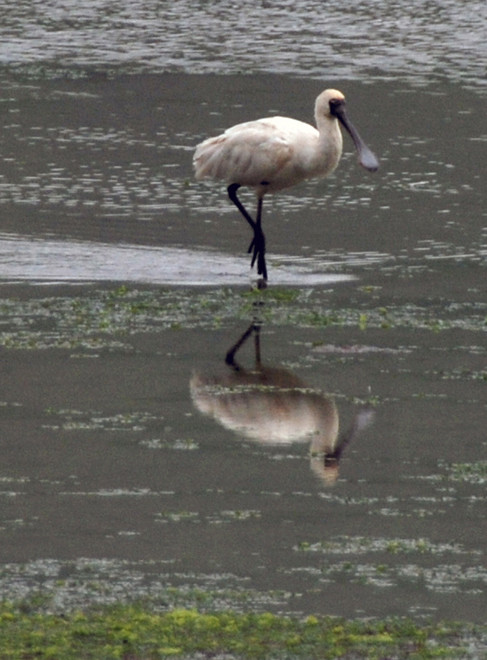XI. Royal Spoonbills
Royal Spoonbills (Platalea regia) are the most peculiar birds. Long-legged with big clawy feet, a bustle of brilliant white feathers, a long flattened bill, yellow eye crescents.
They remind me of the duck-billed platypus and are both flamboyant, when they have their breeding crests (the male's much fuller than the females) and somehow stupid looking. It's something to do with the way the eyes seem to be part of the bill itself. It gives the spoonbill both a beady and myopic demeanor. And that bill like a big proboscis - indeed like the Proboscis Monkey.


Someone describes the feeding thus:
The bird walks slowly, kicking up debris and small animals from the bottom of the body of water, which it senses and catches with its bill. When an item is sensed, the spoonbill switches to intensive sweeping of a small area.
Spoonbills can only feed in water up to 40cm deep so in tidal areas this limits their feeding time.
The first ones arrived from Australia in 1861 and first breeding took place at the white heronry at Okarito in 1949. There are now about a 1000 birds in New Zealand. They tend to nest alongside shags and herons. Their closest relatives are Ibisies - see the Sacred Ibis in my South Africa pages.
We saw them both at Miranda in the North Island and on the Otago Peninsula.
At Miranda we 'saw' them in retrospect when I looked more closely at a photo I had taken of a distant, slightly inland, roosting tree. I had assumed the white birds were egrets or white herons. But on a closer look it turned out they were Royal Spoonbills. It was our first full day in New Zealand, it was hot, and I had no idea what season it was let alone the time.
Their feeding habit is frenetic. They sweep and stabble the water with those big powerful beaks, every now and then lifting up something, shrimp, fish and other crustaceans, to throw it into the back of its throat. And then back to the frenetic feeding.
Apparently the bill is very sensitive. Much more than just two plates of bone or horn clashing together. ' Vibration detectors inside the bill can detect prey in murky water or darkness.'
On the Otago Peninsula I first spotted one roosting on a fallen tree trunk just behind our bach. Then they came feeding in front of the batch. And then we saw six working the tidal flats of Papanui Inlet. I found them hard to photograph - either too fast-moving in poor light or too far away in harsh light that made the contract between their white plumage and jet black legs and bills and faces too much for the camera's sensor to capture.
I suppose the head is naked of feathers in the same way that the vulture's head is naked of feathers - to stop it getting mud or blood all over its plummage.
They are a successful bird. There are six species and they have widespread distribution in the world. They are part of the Threskiornithidae family which includes 34 species of large wading birds - six being spoonbills and the remainder ibises.

I have shamelessly borrowed the great photo by Roger Smith below that shows the Royal Spoonie in all its glory - the huge 'spatulate' bill - the comedy fringe between bill and brow- the bulging eyes - the bustle-y plumage all supported on those jet black, back-bending legs that look both thick and thin at the same time.
To top it all their call is a deep strangulated braying and grunting - click here to hear them against a backdrop of white heron, pied shag, grey warbler, tomtit, and bellbird.









